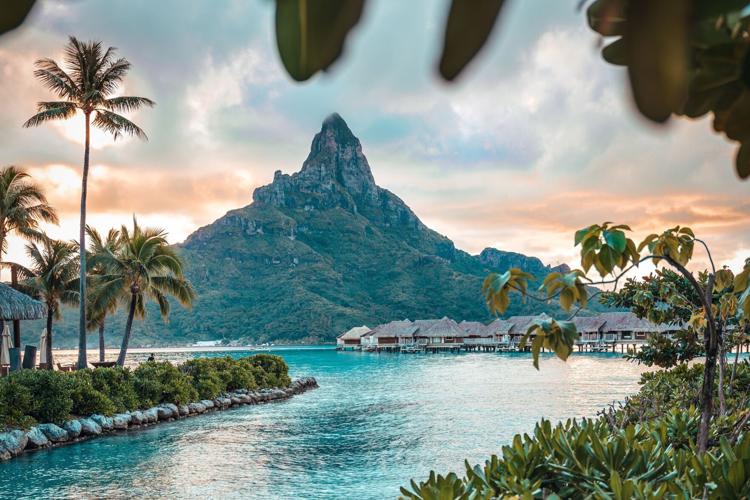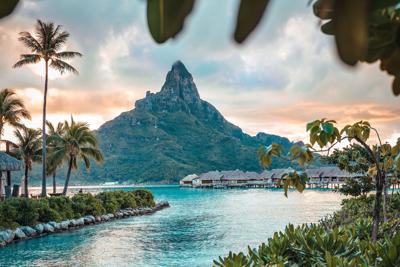The breakfast bounty is set up on a shaded patch of grass: luscious fruit salad served in pineapple bowls and dressed with flamboyant flowers; chia pudding rich with creamy coconut milk; and the most delicious version of poisson cru, Tahitiãs national dish, that Iãve tried to date.
Iãve experienced field-to-table dining before, but not like this ã never so literally, right on a cute, little certified-organic farm, beside papaya trees bearing the fruit Iãm eating. Iãm at , founded by a young husband-and-wife team, Momo Lemaire and Sandrine Pinson, on the French Polynesian paradise of Raiatea.

Faora Lab is a little certified-organic farm, founded by a former chef on the island of Raiatea.
Wing Sze TangLemaire bid goodbye to his restaurant career during the pandemic and started working this lush land, which once belonged to his grand-grandparents and was still a ãbig forestã when he began. He speaks of sustainable, self-sufficient living and supplying produce to neighbours. ãBanana, papaya, avocado ã we try to have everything here,ã says the former chef.
Beyond our small group of travel writers, there are no other guests in sight, only ducks roaming by a pond. This isnãt exactly a tourist attraction ã weãre here on a rare private tour ã though Lemaire expresses vague ambitions to welcome more vacationers someday. Island time has no deadlines.
Our group has been granted access through our tour guide, Naiki Lutz, founder of and a friend of the couple. Besides running her company as practically a one-woman operation, Lutz has the cortisol-calming manner of a yogi, massage therapist or meditation teacher ã in fact, sheãs all of the above. She leads travellers on wellness-themed excursions around Raiatea, which is home to about 13,000 inhabitants and remarkably free of tourist crowds when we visit.

The luscious fruit salad served at Faora Lab, on the French Polynesian island of Raiatea.
Wing Sze TangãâÃýå , we donãt have white-sand beaches or bungalows over water, so weãre not interesting for most people coming here and searching for ãthe postcard.ã But what we do have is authenticity,ã Lutz says. Raiatea is a spiritually and archaeologically important island thatãs home to sacred marae, the open-air temples of ancient Polynesia. These include the UNESCO-recognized , considered the largest and most significant marae of all.
French Polynesia has an aspirational, trip-of-a-lifetime reputation, luring honeymooners swooning over luxury villas perched above the bluest lagoon. But thereãs more to the destination than famous Bora Bora. And itãs still easy to find untrampled places on the quieter islands, as well as countless small (if not tiny) businesses sharing a taste of the local culture and history.
After all, encompasses 118 islands (Tahiti is just the largest), scattered across five archipelagos. Last year, this overseas collectivity of France saw around 262,000 tourists. Thatãs a drop in the ocean compared with its northern ãneighbourã: More than 9.6 million people visited the Hawaiian Islands in 2023.
Historically, French Polynesia has favoured a slow tourism approach. In 2022, the Ministry of Tourism laid out a strategy to cap tourist numbers: no more than 280,000 per year as a ãsustainable threshold.ã
But that was before Moetai Brotherson, the current President of French Polynesia, came to power and declared a new goal: to welcome 600,000 tourists annually by 2033. Itãs an about-face that seems directly at odds with sustainability. How can you more than double the visitors while preserving a place?
The hope is that travellers will spread across all five archipelagos, boosting lesser-known locales. Currently, Tahiti, Bora Bora and Moorea hold more than 70 per cent of the tourist accommodations and activities, so naturally theyãre the most popular. Meanwhile, the island of Raiatea, where I visit Faora Lab, is often overlooked, despite being a 20-minute flight from Bora Bora.

At Le ¯íý¿°µý¿ãa by Pearl Resorts, guests can spot blacktip reef sharks and other marine wildlife in the clear waters around their suites.
Wing Sze TangFrom Raiatea, we boat over to our accommodations on , its little-sister island with a similarly tranquil feel ã as well as coveted overwater bungalows, set on a nearby motu (islet). I check into one at , once I stop gawking at the blacktip reef sharks, small and harmless, swimming in the crystal waters around my suite. The resort is part of a fully Polynesian-owned hotel group ã the only one, in fact.
Home to just about 5,500 people, ¯íý¿°µý¿ãa specializes in one particular commodity, so thatãs what we set out to see: ãThe main activity you can find on the island is vanilla plantations,ã explains Yvann Mama, a genial guide with . Tourism, meanwhile, isnãt yet big business. ã¯íý¿°µý¿ãa is not very known in the world,ã says Mama, estimating that they have only about 15 guest houses and two small hotels.
Taking us on a 4x4 road trip of the island, Mama brings us to a little operation called La Vallûˋe de la Vanille, one of the many purveyors of the spice. Here, we get a crash course on the high-maintenance needs of Tahitian vanilla, prized by gourmands the world over.

A view from ¯íý¿°µý¿ãa, one of the lesser-known islands, where vanilla plantations are the main business.
Wing Sze TangEach flower must be painstakingly pollinated by humans, as the bees here wonãt do the job. Then, for best results, each bean is treated like itãs on vacation, too: suntanning for months, while getting regular massages. ãOne by one. The process is only by hand,ã says Vainui Maiarii, who works at La Vallûˋe, easily convincing us to buy the fragrant souvenirs before we go.
The last stop on our Tahitian itinerary is , where most of the swanky, big-name resorts are located, for reasons that become obvious. Judging by sheer natural splendour alone, with water the shade of gems and dreams, itãs unmatched.
We get a full immersion in the beauty, quite literally, on a private excursion with Pierro Taati of , a small, family-run company. Aboard his boat, with his teenage grandson Kenji as an assistant, he takes us on a loop of the island, entertaining us with his ukulele on the way. We stop periodically to take dips in the lagoon and look for sharks, stingrays and coral reefs. I catch sight of huge cruise ships looming by the shores, perhaps the only distraction from the postcard image.

Pierro Taati of Keishi Tour and his grandson prepare lunch right in the water, with Bora Bora in the background.
Wing Sze TangLunch is right in the sun-warmed water. After pulling up to an empty stretch of beach on a motu, Taati arranges a plastic table and chairs, then barbecues a feast on a basic, old-school grill, piling our plates with surf and turf. As I dine on some of the best lobster Iãve had, with fish tickling my bare legs, I peer at Bora Boraãs verdant mountains, just across the way.
Admittedly, this experience does feel like a novelty tailored for tourists. Still, itãs hard not to be dazzled by the hospitality, the local flavours, the dramatic views. From this vantage point, we donãt see any other travellers, so itãs possible to pretend ã for this moment, if not forever ã that this is still a secluded paradise.
The writer travelled as a guest of Tahiti Tourisme, which did not review or approve this article.






































To join the conversation set a first and last name in your user profile.
Sign in or register for free to join the Conversation